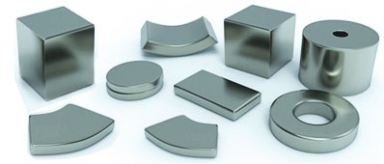Frequently Asked Questions About Magnets & Magnetism

Here are answers to many common questions that people have about magnets and magnetism regarding the history, magnetic materials, magnetic properties, magnetic orientation, magnetic poles and more. For more technical info about these areas, visit our Magnetics-101-Design Guide.
- 1.0 History
- 2.0 The Basics
- 3.0 Magnetic Strength
- 4.0 Magnetic Field
- 5.0 Magnetic Poles
- 6.0 Magnetic Flux
- 7.0 Magnetic Orientation
- 8.0 Magnetic Characteristics
- 9.0 Magnetic Properties
- 10.0 Magnet Operating Temperatures
- 11.0 Machining Magnets
- 12.0 Magnetic Assemblies
- 13.0 Handling & Storage
- 14.0 Magnetic Resources
Send us a request for quote or contact us today for more information about our custom magnets, and let us know how we can help with your specialty requirements. Large inventory of neodymium, samarium cobalt, alnico, ceramic and flexible magnets are also available for on-line purchase at MagnetShop.com.
1.0 A BRIEF HISTORY
The ancient Greeks and Chinese discovered that certain rare stones, called lodestones, were naturally magnetized. These stones could attract small pieces of iron in a seemingly magical way, and were found to always point in the same direction when allowed to swing freely, suspended by a piece of string, or floating on water. Early navigators used these magnets as rudimentary compasses to help them determine their direction while at sea.
The word "magnet" comes from Magnesia, a district in Thessaly, Greece where it is believed that the first lodestone was mined.
Over the years, magnets have evolved into the high-strength materials we have today. It was discovered that by creating alloys of various materials, one could create similar effects to those found in natural lodestone rocks, and increase the level of magnetism.
However, it was not until the 18th century that the first man-made magnets were created. Progress in creating stronger magnetic alloys was very slow until the 1920s when alnico magnet materials (an alloy of nickel, aluminum and cobalt) were formulated. Ferrite magnets were developed in the 1950s and rare-earth magnets in the 1970s. Since then, the science of magnetism has grown exponentially, and extremely powerful magnetic materials have made miniature and powerful devices possible. top
2.0 THE BASICS
What is a magnet?
Magnets can be made by placing a magnetic material, such as iron or steel, in a strong magnetic field. Permanent, temporary, and electromagnets can be produced in this manner.
The atoms forming materials that can be easily magnetized such as iron, steel, nickel, and cobalt are arranged in small units, called domains. Each domain, although microscopic in size, contains millions of billions of atoms and each domain acts like a small magnet. If a magnetic material is placed in a strong magnetic field, the individual domains, which normally point in all directions, will gradually swing around into the direction of the field. They also take over neighboring domains. When most of the domains are aligned to the field, the material becomes a magnet. top
Domains before magnetization

Domains after magnetization

What does a magnet do?
Magnets do the following things:
- Attract certain materials, such as iron, nickel, cobalt, certain steels and other alloys.
- Exert an attractive or repulsive force on other magnets (opposite poles attract, like poles repel).
- Have an effect on electrical conductors when the magnet and conductor are moving in relation to each other.
- Have an effect on the path taken by electrically charged particles traveling in free space.
Based on these effects, magnets transform energy from one form to another, without any permanent loss of their own energy. Examples of magnet functions are:
- Mechanical to mechanical, such as attraction and repulsion.
- Mechanical to electrical, such as generators and microphones.
- Electrical to mechanical, such as motors, loudspeakers, charged particle deflection.
- Mechanical to heat, such as eddy current and hysteresis torque devices.
- Special effects, such as magneto-resistance, Hall effect devices, and magnetic resonance. top
How are magnets made?
Modern magnet materials are made through casting, pressing and sintering, compression bonding, injection molding, extruding, or calendaring processes. Once manufactured, magnets often need to be further processed by grinding or other machining processes, and then assembled into a next level assembly. Visit our manufacturing and assembly page to learn more about our custom machining and assembly capabilities. top
Are there different types of magnets available?
There are three types of magnets: permanent magnets, temporary magnets, and electromagnets.
- Permanent magnets emit a magnetic field without the need for any external source of magnetism or electrical power.
- Temporary magnets behave as magnets while attached to or close to something that emits a magnetic field, but lose this characteristic when the source of the magnetic field is removed.
- Electro-magnets require electricity in order to behave as a magnet. top
There are many different types of permanent magnet materials, each with their own unique characteristics. Each material has a family of grades that have properties slightly different from each other, though based on the same composition. top
What are permanent magnets made of?
Modern permanent magnets are made of special alloys that have been found through research to create increasingly better magnets. The most common families of permanent magnet materials today are made out of aluminum-nickel-cobalt (alnicos), strontium-iron (ferrites, also known as ceramics), neodymium-iron-boron (a.k.a. neodymium magnets, or "super magnets"), and samarium-cobalt-magnet-material. (The samarium-cobalt and neodymium-iron-boron families are collectively known as the rare-earths). top
What are Rare Earth Magnets?
Rare Earth magnets are magnets that are made out of the rare-earth group of elements. The most common rare-earth magnets are the neodymium-iron-boron (neo magnets) and samarium cobalt (SmCo magnets). top
What is a temporary magnet?
Soft iron and certain iron alloys, such as permalloy (a mixture of iron and nickel) can be very easily magnetized, even in a weak field. As soon as the field is removed, however, the magnetism is lost. These materials make excellent temporary magnets, like those used in telephones and electric motors. top
What are electromagnets?
Electromagnets are used when very strong magnets are required. Electromagnets are produced by placing a metal core (usually an iron alloy) inside a coil of wire that carries an electric current. The electricity in the coil produces a magnetic field. The strength of the electromagnet depends on the strength of the electric current and the number of coils of wire. Its polarity depends on the direction of the current flow. While the current flows, the core behaves like a magnet, but as soon as the current stops, the magnetic properties are lost. Electric motors, televisions, maglev trains, telephones, computers, and many other modern devices use electromagnets. top
What are eddy currents?
These are electrical currents that are induced when a magnetic field moves in relation to an electrical conductor that has been placed within reach of the magnetic field. In turn, these eddy currents create a magnetic field that acts to stop the relative motion of the original magnetic field and electrical conductor. top
What do magnets cost?
Magnet materials can vary significantly in cost from one to the other. Here is an approximate guide as to magnet costs:
| Material | BHmax | Relative Cost ($/Pound) |
Relative Cost ($/BHmax) |
| NdFeB | 40 | 35 | 1.7 |
| SmCo | 26 | 60 | 4.9 |
| Alnico | 5 | 25 | 9.5 |
| Ceramic | 3 | 2 | 0.9 |
| Flexible | 1 | 1 | 1.0 |
* Note: the costs shown here are relative costs based on high volumes of magnet materials that have no special machining or other characteristics.
On a cost-per-pound basis neodymium magnets may seem very costly. However, on a cost per BHmax basis, they are not so costly. Using a more powerful magnet, enables the entire device that the magnet goes into to be miniaturized. This yields cost savings that favor more powerful magnet materials. top
Are there industry standards for magnets?
Yes. Standards have been established by the Magnetic Materials Producers Association (MMPA) and the Magnet Distributors and Fabrications Association (MDFA). Both of these associations are now a part of the International Magnetics Association. Some of the publications and standards produced by these organizations are reproduced here for your convenience. top
How do I order magnets?
To efficiently order magnets, you need to have a good idea of what you want to accomplish. Here are a few items to consider:
- General nature of application: holding, moving, lifting, etc.
- Shape of magnet desired: disc, Ring, Rectangle, etc.
- Size of magnet desired: diameter, length, width, height, etc.
- Tolerances: what variation in dimensions is allowed.
- Conditions in which magnets will be used: elevated temperature, humidity, outside, inside, etc.
- Strength of magnet required: in pounds of holding force, Gauss, etc.
- Magnet should cost no more than X: this will eliminate certain materials from consideration.
- Quantities required. (top)
3.0 MAGNETIC STRENGTH
How permanent is a magnet’s strength?
If stored away from factors that adversely affect the magnet such as power lines, other magnets, high temperatures etc., a magnet will retain its magnetism essentially forever. top
What might affect a magnet’s strength?
Factors that can affect a magnet's strength include:
- Heat
- Radiation
- Strong electrical currents in close proximity to the magnet
- Other magnets in close proximity to the magnet
- Neo magnets will corrode in high humidity environments unless they have a protective coating.
Shock and vibration do not affect modern magnet materials, unless sufficient to physically damage the material. top
Will magnets lose their power over time?
Modern magnet materials do lose a very small fraction of their magnetism over time. With samarium cobalt magnets, for example, this has been shown to be less than 1% over a period of ten years. top
Which are the strongest magnets?
The most powerful magnets available today are the rare- earth types. Of the rare-earths, neodymium magnets are the strongest. However, at elevated temperatures (of approximately 150°C and above), samarium cobalt magnets can be stronger than neo magnets, depending on the magnetic circuit. top
What are superconductors?
These are the strongest magnets. They don't need a metal core at all, but are made of coils of wire made from special metal alloys which become superconductors when cooled to very low temperatures. top
Can I make a magnet that I already have stronger?
Once a magnet is fully magnetized, it's "saturated" and cannot be made any stronger. In that sense, magnets are like buckets of water: once they are full, they can't get any "fuller". top
Can a magnet that has lost its magnetism be re-magnetized?
Provided that the material has not been damaged by extreme heat, most magnets can be re-magnetized back to their original strength. top
How do you measure the strength or power of a magnet?
Most commonly, Gaussmeters, magnetometers, or pull-testers are used to measure the strength of a magnet. Gaussmeters measure the strength in Gauss; Magnetometers measure in Gauss or arbitrary units (making it easy to compare one magnet to another); pull-testers measure pull in pounds, kilograms, or other force units. Helmholtz Coils, search coils and permeameters are also used to make sophisticated measurements of magnets.
Special Gaussmeters can cost up to several thousands of dollars. Integrated Magnetics stocks several types of Gaussmeters that range between $400 and $1,500 each. contact us if you are interested in more information regarding these or to place an order. top
If I have a NdFeB magnet with a Br of 12,300 Gauss, will I be able to measure 12,300 Gauss on its surface?
No. The Br value is measured under closed-circuit conditions. A closed-circuit magnet is not of much use. In practice, you will measure a field that is less than 12,300 Gauss close to the surface of the magnet. The actual measurement will depend on whether the magnet has any steel attached to it, how far away from the surface you make the measurement, and the size of the magnet (assuming that the measurement is being made at room temperature).
For example, a 1" diameter Grade 35 neodymium magnet that is ¼" long will measure approximately 2,500 Gauss when 1/16" away from the surface, and 2,200 Gauss when 1/8" away from the surface. top
4.0 MAGNETIC FIELD
What is the strength of the earth’s magnetic field?
The surface field strength of the earth is about 0.5 gauss, but it varies by as much as 10% depending on the strength of the crustal field. A range from 0.85 to 0.45 can be found across the globe. Geomagnetic storms can cause changes of between 1% to 5% that last from a few hours to a full day. top
How does a magnet’s strength drop off over distance?
The strength of a magnetic field drops off more or less exponentially over distance.
Here is an example of how the field (measured in Gauss) drops off with distance for a samarium cobalt Grade 18-disc magnet which is 1" in diameter and 1/2" long:
|
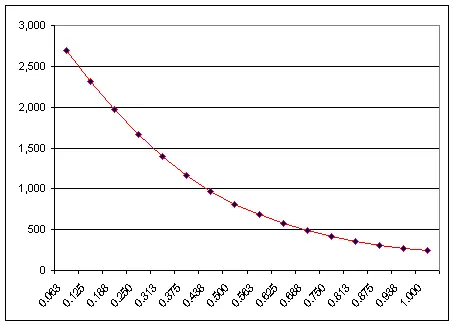
|
What is the governing equation for field strength relative to distance?
For a circular magnet with a radius of R and length L, the field Bx at the centerline of the magnet at distance X from the surface can be calculated by the following formula, where Br is the residual induction of the material):

There are additional formulae that can be used to calculate the field from a rectangular magnet and magnets in other configurations. Use our on-line calculators to determine your own field levels. top
What can I use to block a magnetic field?
Only materials that are attracted to a magnet can "block" a magnetic field. Depending on how thick the blocking piece is, it will partially or completely block the magnetic field. top
5.0 MAGNETIC POLES
What are magnetic poles?
Magnetic poles are the surfaces from which the invisible lines of magnetic flux emanate and connect on return to the magnet. top
What are the standard definitions of “North” and “South” pole?
The north pole is defined as the pole of a magnet that, when free to rotate, seeks the north pole of the earth. In other words, a magnet's north pole will seek the earth's north pole. Similarly, the south pole of a magnet seeks the south pole of the earth. top
Can a particular pole be identified?
Yes, the north or south pole of a magnet can be marked if specified. top
How can you tell which is the North Pole if it’s not marked?
You can't tell by looking. You can tell by placing a compass close to the magnet. The end of the needle that normally points toward the north pole of the earth would point to the south pole of the magnet. top
6.0 MAGNETIC FLUX
How do lines of magnetic flux behave?
Lines of force are three-dimensional, surrounding a bar magnet on all sides.
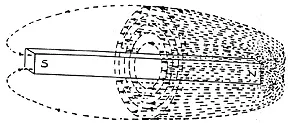
Likepoles repel and unlike poles attract. When opposite poles of a magnet are brought together, the lines of force join up and the magnets pull together.
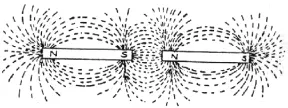
When like poles of a magnet are brought together, the lines of force push away from each other and the magnets repel each other.

7.0 MAGNETIC ORIENTATION
What does “orientation direction” mean?
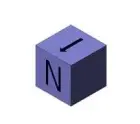
Most modern magnet materials have a "grain" in that they can be magnetized for maximum effect only through one direction. This is the "orientation direction", also known as the "easy axis", or "axis".
Un-oriented magnets (also known as "Isotropic magnets") are much weaker than oriented magnets, and can be magnetized in any direction. Oriented magnets (also known as "Anisotropic magnets") are not the same in every direction - they have a preferred direction in which they should be magnetized. top
8.0 MAGNETIC CHARACTERISTICS
Magnets are characterized by three main characteristics:
- Residual Induction: Given the symbol Br, and measured in Gauss, this is an indication of how strong the magnet is capable of being.
- Coercive Force: Given the symbol Hc, and measured in Oersteds, this is an indication of how difficult it is to de-magnetize the magnet.
- Maximum Energy Product: Given the symbol BHmax, and measured in Gauss-Oersteds, this is an indication of what volume of magnet material is required to project a given level of magnetic flux. top
9.0 MAGNETIC PROPERTIES
What are the properties of commonly used magnet materials?
Here are the three important properties that characterize magnets for some of the most common magnet materials used today:
| Material | Br | Hc | BHmax |
| NdFeB 42 | 13,050 | 12,500 | 42.0 |
| NdFeB 35 | 12,300 | 11,300 | 35.0 |
| SmCo 26 | 10,500 | 9,200 | 26.0 |
| Alnico 5 | 12,500 | 640 | 5.5 |
| Ceramic 5 | 3,950 | 2,400 | 3.6 |
| Flexible | 1,725 | 1,325 | 0.6 |
- NdFeB Magnet Materials Properties Data
- SmCo Magnet Materials Properties Data
- Alnico Magnet Materials Properties Data
- Ceramic Magnet Materials Properties Data
- Flexible Magnet Materials Properties Data
How can I use this information?
Given a magnet size, you can estimate how much magnetic flux different materials will project at a given distance. You can also use this information to compare one material to another.
Example: How much more flux will a neodymium grade 35 magnet project as compared to a ceramic grade 5 of the same dimension at a given distance? Simply divide the Br of the neo 35 by the Br of ceramic 5 (12300/3950) to get 3.1. This means that the neo grade 35 will project 3.1 times the flux a same-size ceramic grade 5 would at a given distance.
Given the flux required at some fixed distance from the magnet, you can use this information to estimate what magnet volume will be required for different magnet materials.
Example: What volume of ceramic-5 magnets would give the same flux as a neodymium grade-35 magnet at a given distance? Simply divide the BHmax of neo-35 by the BHmax of ceramic-5 (35/3.6) to get 9.7. This means that the volume of the ceramic-5 magnets would have to be 9.7 times that of the neo-35 magnet to give you the same flux. top
10.0 MAGNET OPERATING TEMPERATURES
What are the maximum recommended operating temperatures for different magnet materials?
The maximum temperature at which a magnet will be effective depends greatly on the permeance coefficient, or "Pc" of the material. The Pc is a function of the magnetic circuit in which the magnet operates. The higher the Pc (the more "closed" the circuit), the higher temperature at which the magnet can operate without becoming severely demagnetized. Shown here are approximate maximum operating temperatures for the various classes of magnet material. At temperatures, close to those listed below, special attention may be needed in order to ensure that the magnet will not become demagnetized. top
| Material | Approximate Maximum Operating Temperatures |
|
| °C | °F | |
| NdFeB | 140 | 284 |
| SmCo | 300 | 572 |
| Alnico | 540 | 1,004 |
| Ceramic | 300 | 572 |
| Flexible | 100 | 212 |
What is maximum temperature a magnet can operate at not a set value
Magnets function at different levels of efficiency given different circuits that they operate in. The more closed the circuit the magnet is operating in, the more stable it is, and the less effect temperature will have on it. top
11.0 MACHINING MAGNETS
Can magnets be machined?
Yes, magnets can be machined. However, hard magnet materials are extremely difficult to machine, unlike flexible or rubber-type magnet materials. Magnets should be machined in the unmagnetized state as much as possible, using diamond tools and/or soft grinding wheels. In general, it is best not to try to machine hard magnet materials unless you are familiar with these specialized machining techniques. top
How much does it cost to machine magnets?
Factors that determine the cost to machine magnets include:
- Quantity: The larger the quantity, the lower the cost, since set-up charges must be amortized over the quantity, and special tooling can be created to machine larger quantities.
- Material: SmCo materials are more costly to machine since they are very brittle, flexible materials are very inexpensive to machine because of their physical characteristics.
- Shape: Complex shapes are more expensive than simple shapes; and,
- Tolerances: The closer the required tolerances, the more expensive it will be to machine the magnets. top
12.0 MAGNETIC ASSEMBLIES
What is a magnetic assembly?
Magnetic Assemblies consists of one of more magnets, along with other components, such as steel, that generally affect the functionality of the magnet.
How should magnets be assembled to my device?
If a magnet must be fastened to a device, you can use either mechanical means or adhesives to secure the magnet in place.
Adhesives are often used to secure magnets in place. If magnets are being adhered to uneven surfaces, an adhesive with plenty of "body" is required so that it will conform to the uneven surface. Hot glues have been found to work well for adhering magnets to ceramics, wood, cloth, and other materials. For magnets being adhered to metal, "super glues" can be used very effectively.
Integrated Magnetics can supply flexible magnets with adhesives already attached; simply peel off the liner and attach the magnet to your product. Contact us, or send us a request for quote for a specialty order, or visit www.magnetshop.com for large stock inventory available for on-line purchase. top
*As with all adhesive applications, it is very important to ensure that all surfaces being bonded are clean and dry before bonding.
13.0 HANDLING AND STORAGE
Tips on handling and storing magnets
- Always take special care in handling magnets! Magnets can snap together and injure personnel or damage themselves.
- Keep magnets away from magnetic media such as floppy disks, credit cards, and computer monitors.
- Store magnets in closed containers so they don't attract metal debris.
- If several magnets are being stored, they should be stored in attracting positions.
- Because they can easily become demagnetized, alnico magnets should be stored with "keepers", iron or magnetic steel plates that connect the poles of the magnet. top
14.0 RESOURCES
What are some good magnetic reference books?
- Permanent Magnet Design Handbook, by Lester Moskowitz, a 385-page book aimed at the technical layperson.
- Permanent Magnets and their Applications, by Dr. Peter Campbell, a 203-page book aimed at the technical person.
- The Driving Force, by James Livingston, a 310- page book aimed at the non-technical reader. A very well written and interesting book on the history of magnets and some of their more exotic applications. top
Send us a Request for Quote or Contact Us today for more information about our custom magnets, and let us know how we can help with your specialty requirements. Large stock inventory of magnets are also available for on-line purchase at MagnetShop.com.
Request A Quote Contact Us




